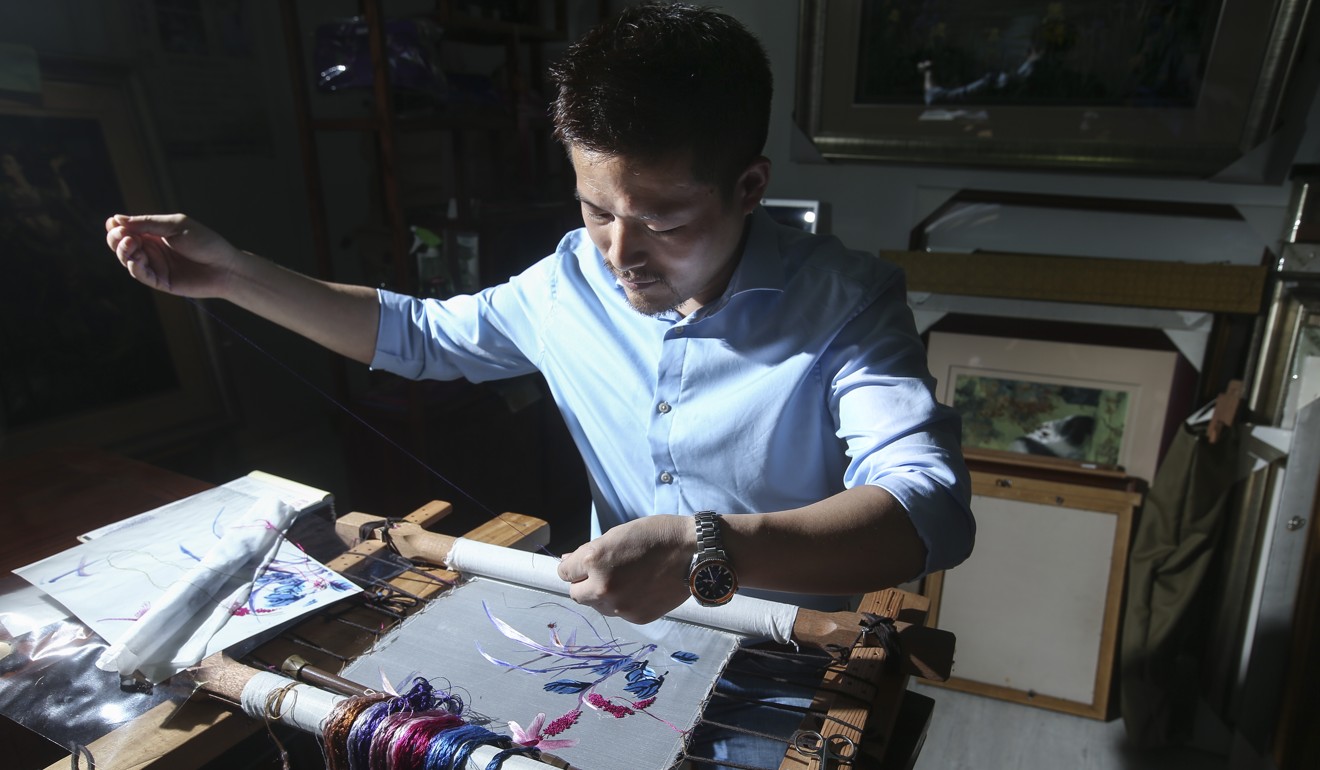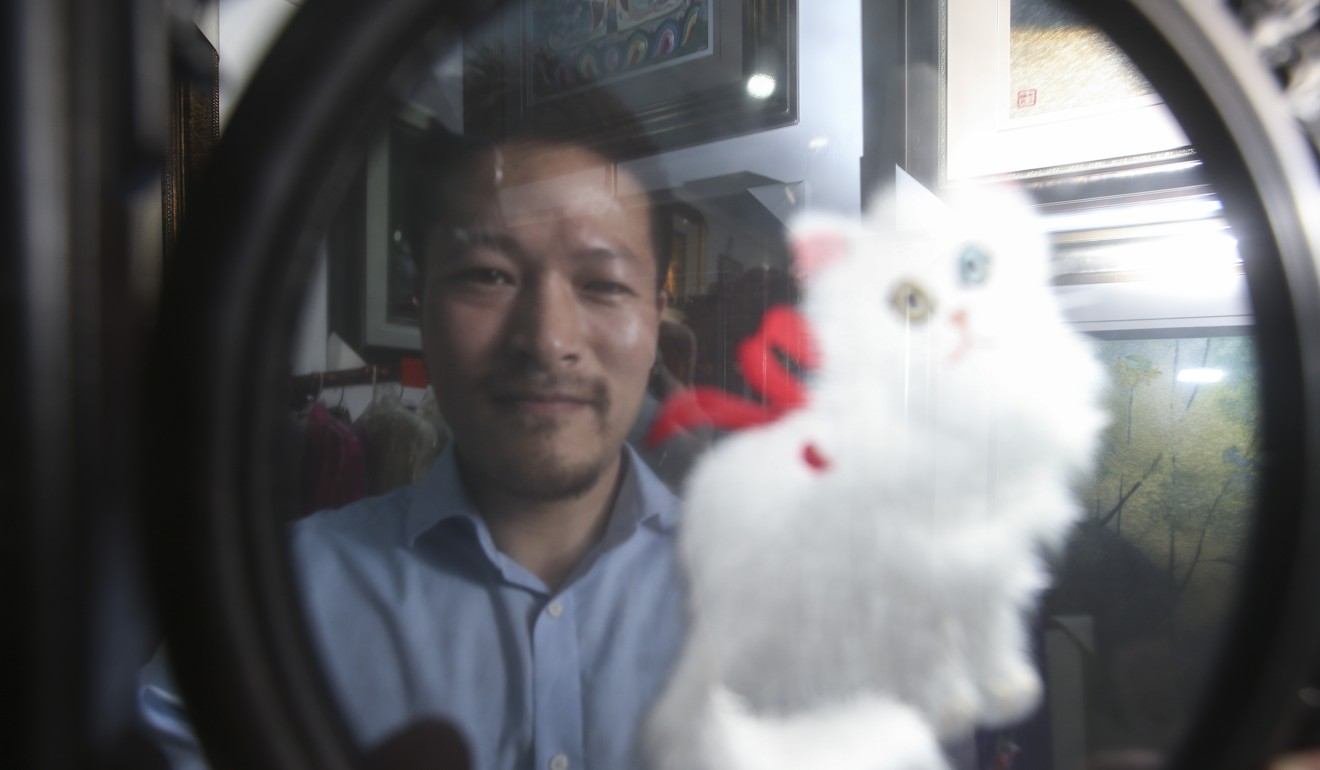
Hong Kong family keeps Ming tradition alive after 400 years in embroidery business
Purveyors of decorative handicraft see growing following in city and on mainland after years focusing on customers in Europe and the US
Entering the Gu family’s shop from the dusty streets of Wan Chai transports you into a world of intricately woven tapestries, exquisitely vibrant colours and unfathomably beautiful designs.
Andy Gu Yu-lai, 37, spends his days amongst this profusion of colours in his store, Gu’s Embroidery, carrying on a family legacy that has its roots in the Ming dynasty.
Silk embroidery has played a role in Chinese culture since the Zhou dynasty (1046 to 256BC), developing over the centuries into what is recognised today as the needlework decorating tapestries, clothing, purses and other products.

“Before my parents fell into the niche of merging art and embroidery, we were like everyone else and did our stitchwork on everyday items, like pillowcases, blanket covers and clothes,” Gu said.
While the Su-style embroidery the family bases its technique on claims more than 2,000 years of history, the Gu proprietors proudly boast over 400 years in the business.
In dynastic China, the family initially created custom products for landlords, wealthy business owners, and imperial officials.
“My family began creating Su-style embroidered paintings and works of art around 100 years ago,” he explained. “I’ve been studying painting and embroidery since I was a small child, and I’ve spent my entire life watching my parents embroider.
Grandma’s classic Hong Kong embroidered slippers given a fashion-forward reboot
“Taking on the family business was natural to me.”
Gu is the third generation of his family to render the famed Su Xiu, or Suzhou embroidery, into paintings and calligraphy.
“What we do these days is the merging of various longstanding aspects of Chinese heritage and culture: calligraphy, brush paintings, and embroidery,” he said. “Our pieces are the crossroads between traditional embroidery and modern art.”
Our pieces are the crossroads between traditional embroidery and modern art
Gu Embroidery first opened its doors in the city in 2005, as the family was keen to try to reach a wider yet more niche audience comprising both the Hong Kong elite and foreign tourists eager to bring home an emblem of Chinese heritage.
“I hope more and more people can become aware of this beautiful Chinese tradition,” he said.
Gu and his older sister, Gu Xiao-xian, are the heirs to the family business. The brother oversees local sales and the international audience it brings, and his sister runs their factories and stores on the mainland.
“Fewer young people are getting into the field of embroidery, so most of the embroiderers are of my parents’ generation,” Andy Gu said.
It was in the 1960s, after over 400 years of thriving business, that the family began merging not only traditional Chinese works of art with embroidery, but also famed Western paintings, “renovating” their already distinctive approach to Chinese needlework.
The Gu family goes far beyond recreating famous paintings by embroidering delicate silken threads into huge tapestries – a process that, depending on the size of the work, can require years to complete. In addition, they create art based on their own designs and ideas.

“The longest I’ve ever worked on a piece is two years,” he said. “It was my recreation of a long Qing dynasty traditional landscape ink painting.”
In recent years, Gu has noticed a shifting demographic among the family’s target audience; a business built for a time on large shipments to Europe or America has seen its fan bases locally and nationally grow.
Today, 50 per cent of buyers hail from the mainland, with Hong Kong and the rest of the world rounding out their customers.
“I’ve noticed more and more people are appreciating this aspect of Chinese culture in the last few years,” he observed. “People are increasingly placing significance on what we do here and increasingly trying to protect the tradition we exalt. And business is increasing.”
“What do we do in a nutshell?” he asked simply enough of a complex skill and art.
“We’ve replaced the paintbrush with the needle, and paint with thread.”

